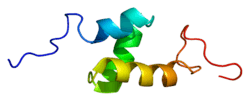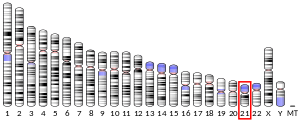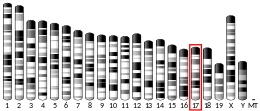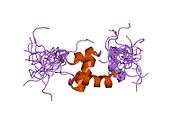UBASH3A
Ubiquitin-associated and SH3 domain-containing protein A is a protein that in humans is encoded by the UBASH3A gene.[5][6]
References
- GRCh38: Ensembl release 89: ENSG00000160185 - Ensembl, May 2017
- GRCm38: Ensembl release 89: ENSMUSG00000042345 - Ensembl, May 2017
- "Human PubMed Reference:". National Center for Biotechnology Information, U.S. National Library of Medicine.
- "Mouse PubMed Reference:". National Center for Biotechnology Information, U.S. National Library of Medicine.
- Wattenhofer M, Shibuya K, Kudoh J, Lyle R, Michaud J, Rossier C, Kawasaki K, Asakawa S, Minoshima S, Berry A, Bonne-Tamir B, Shimizu N, Antonarakis SE, Scott HS (Apr 2001). "Isolation and characterization of the UBASH3A gene on 21q22.3 encoding a potential nuclear protein with a novel combination of domains". Hum Genet. 108 (2): 140–7. doi:10.1007/s004390000453. PMID 11281453.
- "Entrez Gene: UBASH3A ubiquitin associated and SH3 domain containing, A".
Further reading
- Smirnova EV, Collingwood TS, Bisbal C, et al. (2008). "TULA proteins bind to ABCE-1, a host factor of HIV-1 assembly, and inhibit HIV-1 biogenesis in a UBA-dependent fashion". Virology. 372 (1): 10–23. doi:10.1016/j.virol.2007.10.012. PMID 18006034.
- Collingwood TS, Smirnova EV, Bogush M, et al. (2007). "T-cell ubiquitin ligand affects cell death through a functional interaction with apoptosis-inducing factor, a key factor of caspase-independent apoptosis". J. Biol. Chem. 282 (42): 30920–8. doi:10.1074/jbc.M706870200. PMID 17709377.
- Bertelsen V, Breen K, Sandvig K, et al. (2007). "The Cbl-interacting protein TULA inhibits dynamin-dependent endocytosis". Exp. Cell Res. 313 (8): 1696–709. doi:10.1016/j.yexcr.2007.02.017. hdl:10852/28097. PMID 17382318.
- Hu YH, Warnatz HJ, Vanhecke D, et al. (2006). "Cell array-based intracellular localization screening reveals novel functional features of human chromosome 21 proteins". BMC Genomics. 7: 155. doi:10.1186/1471-2164-7-155. PMC 1526728. PMID 16780588.
- Hoeller D, Crosetto N, Blagoev B, et al. (2006). "Regulation of ubiquitin-binding proteins by monoubiquitination". Nat. Cell Biol. 8 (2): 163–9. doi:10.1038/ncb1354. PMID 16429130.
- Gerhard DS, Wagner L, Feingold EA, et al. (2004). "The status, quality, and expansion of the NIH full-length cDNA project: the Mammalian Gene Collection (MGC)". Genome Res. 14 (10B): 2121–7. doi:10.1101/gr.2596504. PMC 528928. PMID 15489334.
- Kowanetz K, Crosetto N, Haglund K, et al. (2004). "Suppressors of T-cell receptor signaling Sts-1 and Sts-2 bind to Cbl and inhibit endocytosis of receptor tyrosine kinases". J. Biol. Chem. 279 (31): 32786–95. doi:10.1074/jbc.M403759200. PMID 15159412.
- Feshchenko EA, Smirnova EV, Swaminathan G, et al. (2004). "TULA: an SH3- and UBA-containing protein that binds to c-Cbl and ubiquitin". Oncogene. 23 (27): 4690–706. doi:10.1038/sj.onc.1207627. PMID 15107835.
- Strausberg RL, Feingold EA, Grouse LH, et al. (2003). "Generation and initial analysis of more than 15,000 full-length human and mouse cDNA sequences". Proc. Natl. Acad. Sci. U.S.A. 99 (26): 16899–903. doi:10.1073/pnas.242603899. PMC 139241. PMID 12477932.
This article is issued from Wikipedia. The text is licensed under Creative Commons - Attribution - Sharealike. Additional terms may apply for the media files.





